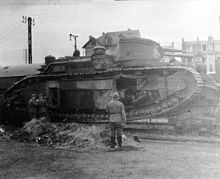Char 2C
| Char 2C | |
|---|---|

Drawing of a Char 2C |
|
| General properties | |
| crew | 12 |
| length | 12 m |
| width | 3 m |
| height | 4.09 m |
| Dimensions | 68 t |
| Armor and armament | |
| Armor | 22-45 mm |
| Main armament | 75mm cannon |
| Secondary armament | four 7.92 mm machine guns / 155 mm cannon |
| agility | |
| drive |
2 × 184 kW (2 × 250 PS) |
| Top speed | 15 km / h (road) 8 km / h (terrain) |
| Power / weight | 5.3 kW / t (7.4 PS / t) |
| Range | 150 km |
The Char 2C or Char de Rupture (German: breakthrough tank) was a French tank that was planned in 1917, but was only built after the First World War . It was delivered from 1922 and for a long time was the best armored combat vehicle in the world.
It was equipped with a 75-mm cannon and four machine guns, one of which had a 155-mm cannon instead of the MG. With a length of 12 meters and a weight of 68 tons, it was almost twice as long and more than twice as heavy as the German A7V . The high weight was due to the enormous size and armor. With the 1260 liters of fuel in seven fuel tanks, a range of 150 kilometers was achieved.
history
At the beginning of World War II , all ten tanks built by the Forges et Chantiers de la Méditerranée company were ready for action. They were combined in a separate tank battalion, the 51st Bataillon de Chars de Combat . The tanks were already obsolete, slow and easily vulnerable by then, but were still used for propaganda purposes. To do this, they were named after historical provinces of France :
| number | Surname |
|---|---|
| 90 | Poitou |
| 91 | Provence |
| 92 | Picardy |
| 93 | Alsace |
| 94 | Brittany |
| 95 | Touraine |
| 96 | Anjou |
| 97 | Normandy |
| 98 | Berry |
| 99 | Champagne |
Normandy was renamed Lorraine in 1939 .
The tanks were deliberately not used in combat, but were used by propaganda as invulnerable "super tanks". After the German Reich broke through the French lines during the western campaign , the decision was made on June 10, 1940 to bring the Char 2C south. The transport train was stopped by a burning train on June 15, 1940 and the tanks had to be blown up so as not to let them fall into the hands of the Germans. German propaganda spoke of a Stuka attack. Despite the explosions, a tank, Champagne , more or less functional, was captured and brought to Berlin.
variants
In 1926, Champagne was converted to the Char 2C bis , which received a 155 mm howitzer instead of the four MG . This conversion was only carried out on a test basis, the tank was returned to its original condition in the same year.
In 1939 Lorraine was upgraded to withstand German anti-tank weapons. For this, the front armor was increased to 90 mm and the side armor to 65 mm. This was the strongest armor at the time and, weighing 75 tons , made Lorraine the heaviest armored fighting vehicle that was ever used operationally.
See also
Web links
- Char 2C in WWII Vehicles (Engl.)
- Char 2C at chars-francais.net (French)
Individual evidence
- ↑ On the ruins of the "Grande Nation" . In: Innsbrucker Nachrichten . August 27, 1940, p. 3 ( ANNO - AustriaN Newspapers Online [accessed on May 18, 2020]).

